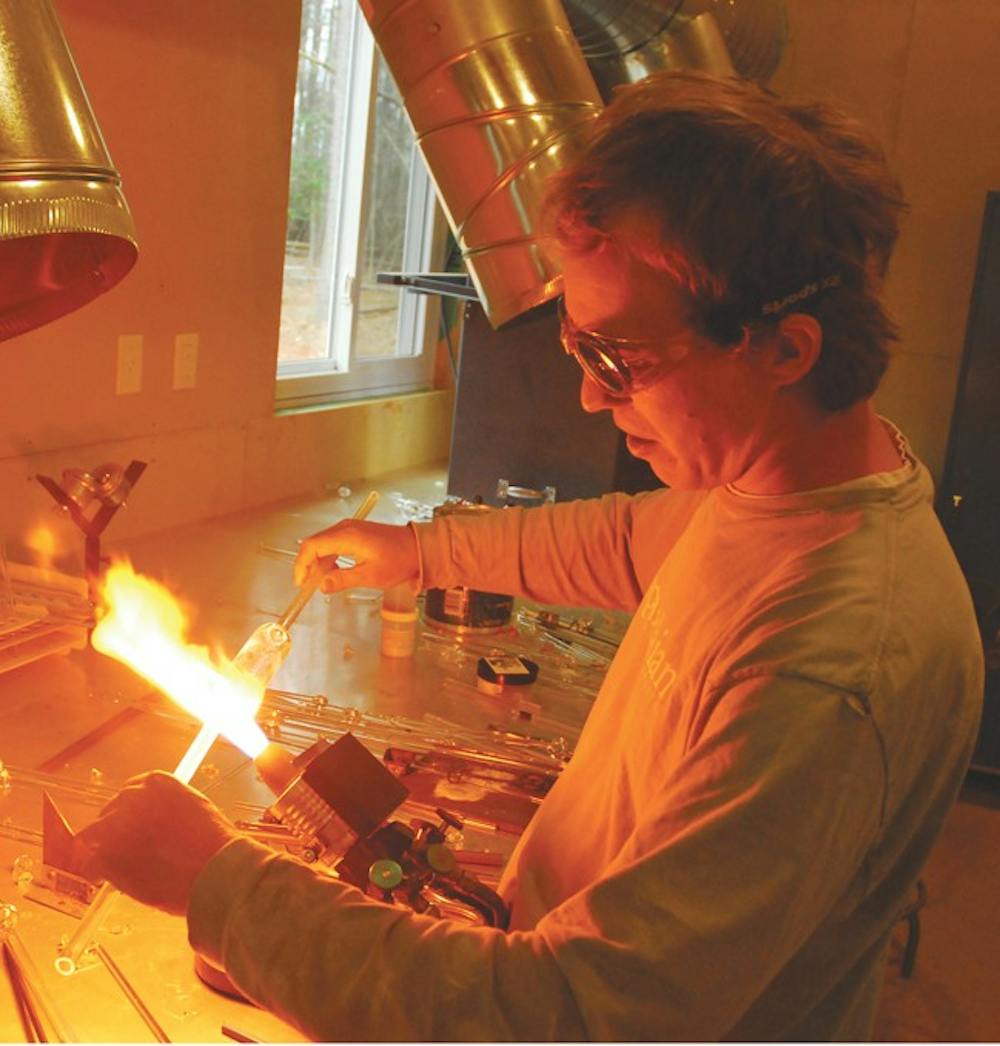Using a variety of pipes, colored glass and flame, local artists are turning clear glass into colorful works of arts.
Dmitri Resnik, his sister, Sally Resnik Rockriver, and Jonathan Davis each call glass art a career, earning their living producing aesthetic pieces.
They use different methods, working with either a furnace or flamework, to create functional and nonfunctional works.
Flamework
Local farmer and glass artist Davis works with a torch to create his pieces, a technique called flameworking.
Davis has a studio in Pittsboro where he creates his art and teaches classes. Though he works with torches, he doesn’t teach or make pipes.
He says the art of flamework just fell into his lap. After dabbling in classes at a variety of universities and community colleges, Davis landed a job when a friend opened a glass blowing studio in Durham and asked him to help out.
“I’d never wanted to do glass art, I didn’t have a particular draw to glass,” he said.
Davis makes wine and champagne glasses, though they are too delicate to be used, and is developing skills to sculpt the human form.
Sculpture versus function
Rockriver creates innovative abstract sculptures with glass.
Her favorite pieces are those that remind her of other planets, as well as earthly geological formations. Often, she grows rock formations within her glass vessels, an art form she calls geochemical sculpture.
Rockriver graduated from UNC with a degree in art before teaching ceramic art at Minnesota State University Moorhead. She took a class there in glass blowing and pursued more formal training in working glass in a furnace before returning to Chapel Hill.
“I enjoy making things that do and say what I want to make,” Rockriver said. “My work is definitely nonfunctional.”
To her, however, it’s the process that matters most. “I like the act of making all of my work, but that doesn’t mean I necessarily like everything I make,” she said.
Rockriver’s brother, Resnik, also pursues this rare trade. Resnik traveled to New Orleans to pursue a music career in rhythm and blues once he graduated from UNC.
He then added visual arts to his musical career after making a paperweight in his sister’s glass studio and studying at the New Orleans School of GlassWorks & Printmaking Studio.
Resnik prefers to create functional pieces, including usable vases, bottles and paperweights.
“I try to make traditional forms with basic color application,” he said.
He wants to make his art accessible to a larger group of consumers by combining aesthetics and practicality.
“Not everyone can buy a $2,500 sculpture for their coffee table,” Resnik said. “But anyone can buy a $50 bottle or a $20 paperweight.”
Pipes
For college students, the most familiar form of glass art usually is its most controversial — a pipe.
Davis compared pipe-making to graffiti art as an underground art form that is mainly misunderstood.
“Some people appreciate it, some people get it,” Davis said. “It’s funny how these things morph into what is publicly acceptable.”
Pipes are made through flamework, not through furnace work. All the artists agreed it is a taboo art form.
“When I studied in school, the teachers asked, ‘You’re not going to take these skills and just make bongs, are you?’” Resnik said. “There are way too many people out there making pipes.”
Contact the Arts Editor at arts@unc.edu.
Glass artists wield ?ames to form their creations

Jonathan Davis uses a torch to shape a glass piece. DTH/ /Lauren Vied



